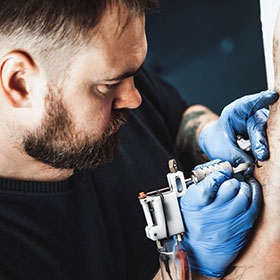Yes, throat tattoos do hurt. The skin on the throat is thin and sensitive.
Tattoos on the throat are a bold choice. They involve more pain than tattoos on other body parts. The throat has less fat and muscle, making it more sensitive. This area also has many nerve endings, which increases the pain level.
For those considering a throat tattoo, it’s important to be prepared. Understanding the pain involved can help in making an informed decision. In this blog, we will explore the factors that contribute to the pain of throat tattoos. We will also provide tips on managing the pain and the healing process. If you are thinking about getting a throat tattoo, read on to learn more.
Introduction To Throat Tattoos
Throat tattoos are becoming more popular. They are bold and visible. Many people choose this spot to make a statement. The skin on the throat is thin. This can make the process more painful. Some say it hurts more than other places.
Throat tattoos are trending now. Celebrities and influencers are getting them. Social media shows many throat tattoo designs. This increases their popularity. People want unique and striking looks. Throat tattoos give this impression. They are hard to miss.
Artists love working on the throat. It is a great canvas. The area allows for creative designs. Each tattoo can be very detailed. This makes them special and unique. People appreciate the artistic value. It shows a strong commitment to body art.
Pain Perception
Pain thresholds vary from person to person. Some people feel more pain. Others feel less. Throat tattoos are painful for most. The skin on the neck is thin. This makes it more sensitive. Bones and nerves are close to the surface. This can add to the pain.
Mental state affects pain. Being calm can reduce pain. Anxiety can make it worse. Focus on breathing. It helps to stay relaxed. Think positive thoughts. Distract yourself with music. Pain is less if your mind is at ease.
Anatomy Of The Throat
Throat tattoos can be very painful. The neck has many sensitive areas. Thin skin and many nerve endings make it more painful. Pain levels can differ for each person.
The neck has many delicate spots. The skin is thin. Muscles are close to the skin. This can make the tattooing hurt more. The front of the throat is very sensitive. The sides can also be painful.
The throat has many nerve endings. These nerves can make the pain worse. Tattoos near the windpipe can hurt more. The pain can feel sharp. It can also feel like pressure. Each person feels it differently.
Tattooing Process
The needle goes into the skin about 1.5 to 2 millimeters. This is deep enough to reach the dermis, the second layer of skin. The depth is crucial. Too shallow, the ink fades quickly. Too deep, it can cause scarring and more pain.
Artists use different techniques based on experience and style. Some use a steady hand to apply ink smoothly. Others use a dotting method for detailed designs. The technique affects the pain level. Smooth strokes might hurt less. Dotting can feel more intense.
Pain Management
Throat tattoos can be quite painful due to the thin skin and numerous nerve endings in the area. Many people report significant discomfort during the process. Pain levels vary, but a skilled artist can help manage it better.
Anesthetics
Anesthetics can help reduce pain during a tattoo session. Some people use numbing creams. These creams make the skin less sensitive. Not everyone needs them. But they can be helpful for first-timers. Always ask your tattoo artist before using any product.
Breathing Techniques
Deep breaths can help manage pain. Breathe in slowly. Hold your breath for a moment. Then breathe out slowly. Repeat this during the tattoo session. It helps to stay calm. This can make the pain less intense. Focus on your breath. It really helps.
Aftercare And Healing
Throat tattoos can be very painful. The skin is thin and sensitive. Pain may last for a few days. Ice packs can help reduce swelling. Avoid touching or scratching the area. This can cause more pain and infection. Take painkillers if needed, but follow the doctor’s advice.
Keep the tattoo clean and dry. Wash gently with mild soap. Pat dry with a clean towel. Apply a thin layer of healing ointment. Avoid soaking in water or swimming. Wear loose clothing to avoid irritation. Do not expose the tattoo to direct sunlight. Follow your artist’s aftercare instructions carefully. Healing usually takes 2-3 weeks.
Comparing Pain Levels
Throat tattoos can be very painful. The skin is thin and sensitive. There are many nerves in this area. This makes it hurt more than other places. Areas like the arm or leg usually hurt less. They have thicker skin and fewer nerves. Some people find the pain intense but bearable. Others say it is the worst pain ever.
Many people share their throat tattoo stories. Some say the pain was sharp and burning. Others describe it as a dull ache. Pain levels vary for everyone. Your pain tolerance and mood can affect how you feel. Eating well and resting can help you handle the pain better. Each person’s experience is unique.
Expert Opinions
Many tattoo artists believe throat tattoos are more painful. The skin is thin. The area is sensitive. Some clients say it’s like a sharp pinch. Others describe a burning sensation. Artists suggest people should prepare for intense pain. Experienced tattoo artists can help. They know how to manage pain. They recommend deep breaths. Staying calm helps too. Each person’s pain level is different. It’s important to be ready for this.
Doctors say throat tattoos can hurt a lot. The throat has many nerve endings. This makes it very sensitive. Some people feel a throbbing pain. Others may feel a burning or stinging. Doctors advise thinking carefully. Tattooing this area can lead to swelling. It can also cause infection if not cared for. Pain relief options are available. Over-the-counter painkillers can help. It’s good to know what to expect.
Conclusion
Considering a throat tattoo? Yes, it does hurt. The throat is sensitive. Pain levels vary. Some feel intense pain, others less so. Everyone’s pain tolerance differs. Proper care is crucial. Healing takes time. Research your artist. Ensure they are experienced.
Safety first. Think carefully before deciding. A throat tattoo is a big commitment. Make sure you’re ready.

